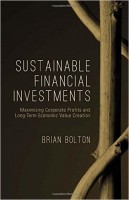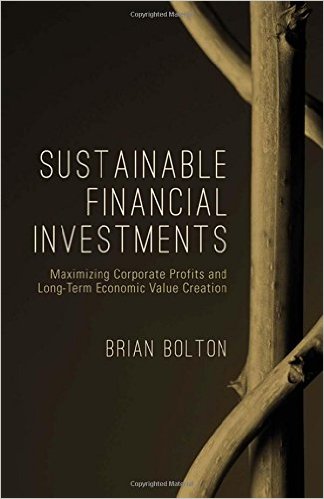 Author: Brian Bolton
Author: Brian Bolton
Publisher: Palgrave Macmillan – 231 pages
Book Review by: Sonu Chandiram
The word ‘sustainable’ brings to mind these adjectives: defensible, justifiable, long-lasting, persistent, reasonable, semi-permanent (if not permanent), solid, and survivable. Sometimes, companies come out with a great new gadget and its earnings double or triple. But after a few years, interest in that product wanes, or copycats come out with a similar product priced far less.
The company cannot or perhaps will not compete on price, and earnings go back to the level they were before that product came out. Result: unsustainable earnings.
This book is about sustainable investments. While one can invest his or her own effort, expertise, labor, and time, or those of others’ such resources to get some form of outcome that may be some change in quality of life, the primary type of investment this book focuses on is financial. That is why the words ‘profits’ and ‘value’ are part of its full title.
In it, the author Brian Bolton shows us what are the characteristics of any sustainable financial investment, and gives us examples of companies (e.g. Nike, Whole Foods, and Interface) making such investments. He writes that the purpose of this book “to connect disparate areas of sustainability, investing and corporate finance to show how to incorporate traditional economic drivers, shared value, social enterprise, innovation, risk management, and other factors into the evaluation of any type of investment.”
Bolton asserts that the purpose of any investment is to create value, and this book provides you the tools to see and utilize the interdependence of various types of assets to create and sustain value over the long term. Some key assets and factors are: the environment, expertise, ideas, innovation money, people, and even social interaction. The way to create sustainable financial investments is discussed, and examples given in the chapters of this unusual book:
- The Purpose of the Firm
Appendix: Firms Making Sustainable Financial Investments
- The Role of the Firm’s Stakeholders
- The Sustainability of Economics
- The Economics of Sustainability
- Valuation of Sustainable Financial Investments
Appendix: Valuation of a Rooftop Solar System
- A Systems Perspective of the Firm
- Economic Development and Sustainable Financial Investments
The chapter I found most interesting and closest to the task of how to value a sustainable investment is 5, Valuation of Sustainable Financial Investments. It begins with a paragraph that I suppose briefly sums up Bolton’s thoughts about return on investment, or the long-term future value of investments made today:
“We invest resources today with the expectation of some kind of return in the future. This return can be a financial return, or it can be something more abstract, such as quality of life, or social welfare. The decisions a firm makes today are motivated by the firm’s mission to maximize value; to do this, the firm needs to understand what will drive the economics in the future. Investments are long-term predictions about the future. Value is created when our predictions about the future are right.”
He goes further by saying that in valuing investments, the three most important questions are:
- What are the cash flows?
- When do the cash flows occur?
- What are the cash flows worth today?
As a discussion point on this topic of valuation, Bolton mentions that stock market values the innovative car company Tesla Motors at around $30 billion (Yahoo Finance shows its value at $27.98 billion today – Oct 12, 2015, with each share worth around $215). What this means is that a small group – say 28 – of super-wealthy investors may want to put up $1 billion each to get full rights to the nearly $28 billion future cash flows and operations of that company.
One of the bets Tesla is making is that most consumers do want a driverless or self-driving car guided by computer. Tesla CEO Elon Musk recently announced that owners and buyers of the Tesla Model X car will be offered the Autopilot mode in a few months from now.
This is a very interesting book that I highly recommend you read if you are interested in business and investing.
Author:
Brian Bolton is an Associate Professor of Finance at Portland State University in Portland, Oregon. Prior to entering academia in 1999, he worked as a research analyst with a private equity group and as an acquisition analyst with a large consulting firm. His research has appeared in such large mainstream publications as The New York Times, the Wall Street Journal, and Bloomberg/BusinessWeek, and has been cited by the U.S. Department of the Treasury.
He has taught finance courses in financial analysis and valuation, corporate finance, financial markets, financial institutions, and economics and sustainability at both undergraduate and graduate levels at Portland State University, the University of New Hampshire, and the University of Colorado.
He has led numerous seminars on the integration of sustainability, finance and strategy for schools and companies around the world. He has published over 20 articles in the Journal of Financial and Quantitative Analysis, Journal of Corporate Finance, Columbia Law Review, and numerous other journals and books.







